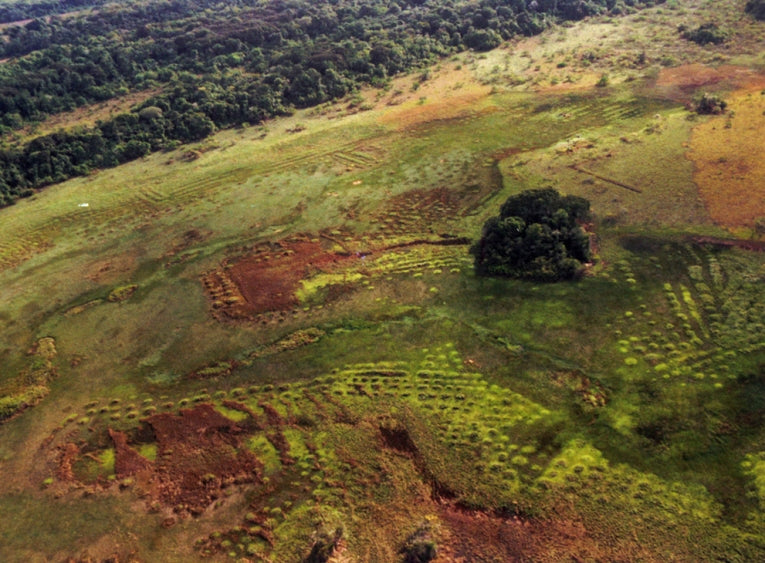The famed black soils or tera preta of the Amazon forests were created by burning and composting, in an Pre-Columbian style that is still much admired. That soil is used as valuable compost still and has been known to add a further centimetre per annum if left to "grow" on its own, as it has been of course in many areas of the Amazon since Columbian times.
In the vast and productive savannahs of Central and South America, Pre-Columbian farmers did not use this burn and fertilize approach to agriculture. A PNAS paper now proves the point. International palaeo-ecologists and anthropologists collaborating in French Guiana have proved that an interesting and very successful method for farming savannah there could be easily adapted for modern farmers.
While Creole farmers later used raised areas for crops which they drained to avoid flooding, the advanced Pre-Columbians had beautifully-symmetrical patterns of raised beds that appeared to need no draining, even in the wet season. More importantly, pre 1492, very little charcoal is found in sample cores, whereas there seems to be a sharp increase in slash-and-burn on these coastal savannahs after the "Columbian Encounter" (CE.)

Locality of the study area; Credit: PNAS
Of course, we have learnt to our cost how wrong we can be about South American history. From the late Holocene onward, the Otomac in Venezuela, the Tainos in Hispaniola and the Arauquinoid civilisation in Suriname have been illustrated using tools to raise small circular mounds in a pattern. This encouraged moisture retention in several ways, as well as drainage (for the wet season) and soil aeration.
Fertility was enhanced and it's possible that weeding and harvesting was also improved, just as we raise beds in gardens for disabled or elderly people. Fish and turtle farming between the mounds could well have provided renewable nutrients. The end result was certainly a large population in the famed civilisations which were very well fed. Maize and manioc were the principal crops involved.

Credit: PNAS
(A) Infrared aerial view of Sable Blanc colonial raised beds located on top of a forested marine terrace showing small rectangular agricultural raised beds. (photo: Societe Avionjaune, Montpellier).
(B) Field view of Sable Blanc.
(C) Profile of excavation in Sable Blanc raised beds showing charcoal lenses below the beds, indicating that colonial farmers opened forested patches on marine terraces to build the beds.
The previous idea had been that pre-Columbian burning was replaced by less of the anthropogenic burning and reforestation. In the forests, this appears to be partly true. What Exeter University's Jose Iriarte and all of his French and US colleagues have stated here is that their high-resolution pollen, phytolith and charcoal sediments show a different story.

The pollen of sweet corn (Zea mais) was extracted from sediment cores, circa 1200 A.D.; Credit: Dr. Bronwen Whitney, 2012
The slash-and-burn, labour intensive systems employed since Columbus have destroyed these savannah resources, that comprise 20% of the lowland neo-tropics. Without them, we need to be alarmed about our capacity to feed growing populations and our inability to stop emitting carbon. The early Indian populations restricted fire use and managed their raised-field savannah over two or more centuries.
As Dr Iriate states forcibly, "This ancient, time-tested, fire-free land use could pave the way for the modern implementation of raised-field agriculture in rural areas of Amazonia. Intensive raised-field agriculture can become an alternative to burning down tropical forest for slash and burn agriculture by reclaiming otherwise abandoned and new savannah ecosystems created by deforestation. It has the capability of helping curb carbon emissions and at the same time provide food security for the more vulnerable and poorest rural populations."
href="https://earthtimes.org/index.html">Homepage









